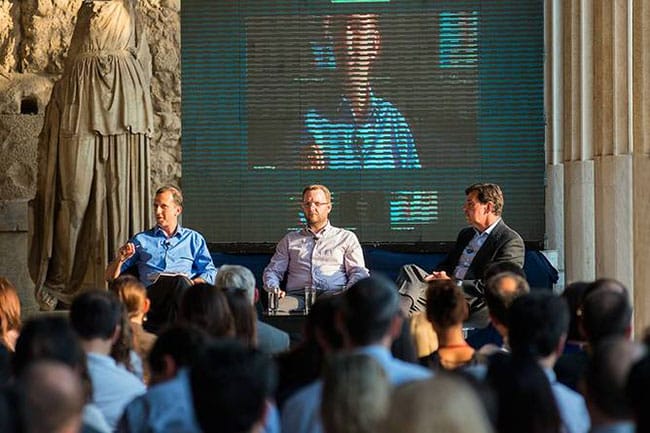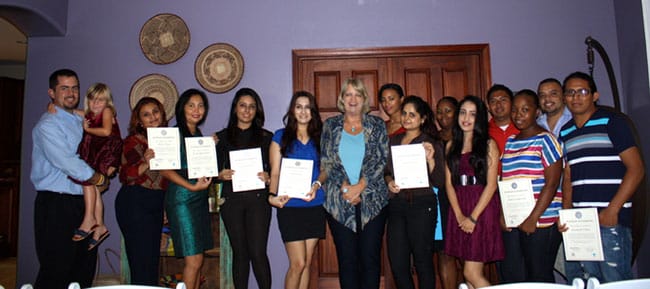In April 2014, I developed a MOOC on entrepreneurship for Case Western Reserve University which to date has attracted more than 39,000 students from 190 countries.
Once the course launched, the MOOC team and I spent hours reading and responding to posts on my discussion boards. I answered hundreds of student emails and connected with them on LinkedIn. I hosted weekly live online panel discussions via WebEx with international thought leaders on entrepreneurship to provide more opportunities for student engagement. I even visited with MOOC students in Greece, Macedonia, the Czech Republic and Spain on a trip sponsored by the U.S. Department of State.

The “Beyond Silicon Valley” MOOC Meet-Up in Athens, Greece, on June 11, 2014. Photo credit: Yiorgis Yerolympos.
Despite our efforts, the amount of face-to-face interaction with students was limited, a common criticism of online courses.
As Dhawal Shah, CEO of MOOC review aggregator Class Central, has put it, “MOOCs have unbundled courses from universities in a way that scales top-quality, affordable learning experiences to willing students across the world … but one thing they do not provide is in-person interaction, which can be critical for many students and types of courses.”
To address this issue, a movement in the MOOC world has begun to host local meetups. Students independently organize gatherings in public places, such as a library or university classroom. They discuss course topics to deepen their understanding of the material and build local networks and support groups.
My MOOC on Coursera, “Beyond Silicon Valley: Growing Entrepreneurship in Transitioning Economies,” uses my home city of Cleveland, Ohio, as a case study for students to understand and learn how to grow an entrepreneurial ecosystem.
Watch one of Professor Goldberg’s recorded panel discussions for his “Beyond Silicon Valley” MOOC.
After years of economic decline, Cleveland was ranked last by Entrepreneur magazine in 2002 for support of entrepreneurship. At this low point, about 13 years ago, a massive effort was launched to develop Cleveland’s startup community. Cleveland could not create a startup community like Silicon Valley. The city doesn’t have droves of young tech billionaires making investments in local startups. Instead, community leaders got creative and recruited support from people and institutions that were not typically associated with a startup community. Government, public and private donors, and the private sector worked to develop an entrepreneurial ecosystem providing funds, mentoring and resources for new businesses.
I created a MOOC so that people in other communities could learn from Cleveland’s journey. Implementing a Cleveland-like strategy to develop a startup-friendly community requires time, money, support and leadership from an array of people, and a coordinated effort.
To catalyze discussions, I encouraged my students to organize local meetups to explore ways of applying the lessons from my course.
One MOOC student, Arjan Tupan, in Düsseldorf, Germany, accepted the challenge. Tupan, an entrepreneur who started his own consulting company, brought together local partners—including the university EBC Hochschule, the nongovernmental organization StartupDorf and the Consulate General of the United States in Düsseldorf—to host meetups in two local spaces in the German city.
During their meetup sessions, students watched video lectures from the MOOC, hosted local experts as guest speakers and engaged in brainstorming sessions to discuss ways to improve support for entrepreneurship in Düsseldorf. At their fifth and final meetup in November, the group developed several projects for 2015, including the creation of “pitch clinics” for entrepreneurs, a local startup Hall of Fame and a shared calendar for the entrepreneurship community.
Local meetups organized by Tupan and other partners around the world had a significant impact on the learning experience of the “Beyond Silicon Valley” MOOC students. These grassroots gatherings gave students the same opportunity to learn from one another as in a traditional classroom, as Jeff Wofford, the facility manager at the U.S. Embassy in Belmopan, Belize, who facilitated MOOC-inspired meetups in Belize, experienced.
“Students here gained a lot of insight by taking the time to sit and discuss the lessons in person,” Wofford told me. “We had a nice cross-section of attendees, from University of Belize students to Belizeans who had owned and operated businesses for decades. In several instances, a comment made by one of the students lead to one of those great aha moments with another student, and the exchanges went both ways.”

Participants in the “Beyond Silicon Valley” MOOC Meet-Ups at the Deputy Chief of Mission Residence, United States Embassy, Belmopan, Belize, in June 2014. Photo credit: U.S. Embassy Belmopan.
I worked with U.S. embassies and consulates, local universities, seed accelerators and the Microsoft Innovation Centers to organize meetups around the world. Some partners translated subtitles of my video lectures into local languages, which also deepened the student experience and helped reach a larger audience. Beyond Silicon Valley has been translated into 10 languages, the most of any course on the Coursera platform.
I am not alone in emphasizing meetups as an integral part of my MOOC. More than 60 groups in 52 cities have formed to take MOOCs together on Meetup, the world’s largest network of local groups. Coursera, the largest provider of MOOCs, has a Learning Hubs Initiative, which establishes physical spaces for students to access their classes. Coursera reports that their Learning Hubs participants show higher completion rates ranging from 30 to 100 percent versus the 6.8 percent average on the Coursera platform.
Researchers at the Computer-Human Interaction in Learning and Instruction Lab (CHILI), at the École Polytechnique Fédérale de Lausanne in Lausanne, Switzerland, reported in a June 2014 study that “watching MOOCs in groups provides (a) highly satisfying learning experience as learners feel connected and interactions among them are enabled.” As the BBC’s Sean Coughlin wrote in his April 2014 article about the expansion of MOOC meetups around the world, “even virtual students want to have a cup of coffee and a conversation after a lecture.”
I enjoy teaching my traditional face-to-face courses at the Weatherhead School of Management at Case Western Reserve. Each semester, I have the opportunity to meet and nurture the professional growth of more than 200 students. That experience is valuable and presents opportunities that a student is unlikely to derive from a MOOC. But the “Beyond Silicon Valley” MOOC has demonstrated to me that online courses can be incredibly effective and spread ideas to people in corners of the world who may never travel to Cleveland, or be able to afford a class at a school like Case Western Reserve. Despite the lack of professor-student interaction, local meetups can produce a more meaningful educational experience and spark innovation for the online student.
Teaching is not an end in itself. I don’t see my job as simply to deposit new information into the heads of my students. A course should inspire students to think, reflect and act—to create something new and worthwhile in the world and influence the future. With an online course, students must by necessity take responsibility for their learning and how they engage with and act upon their knowledge. Fostering this process and watching it unfold through my MOOC has been one of the most gratifying experiences. I can’t wait to see what the students will produce in 2015.
Learn more about one of Wharton’s MOOC initiatives, the Wharton Foundation Series on Coursera, in the video above.
Editor’s note: The original version of this article appeared on The Conversation on Jan. 22, 2015.

























